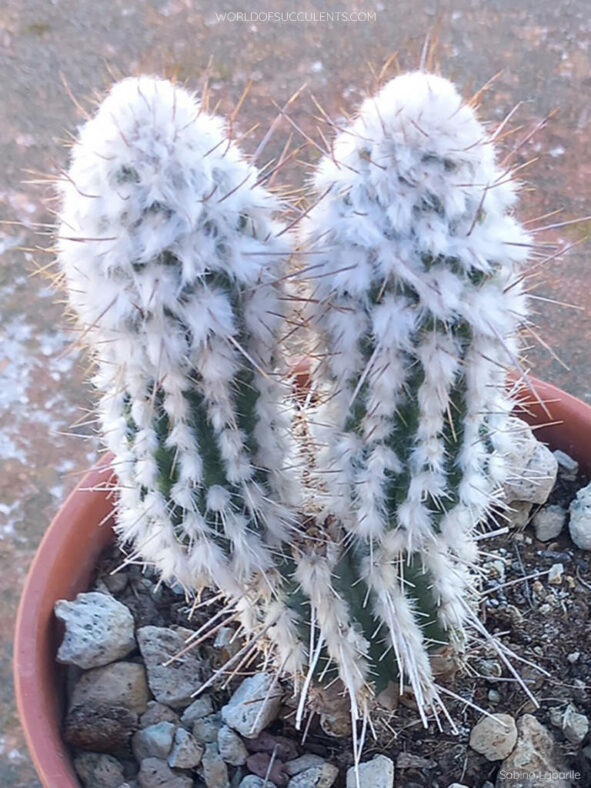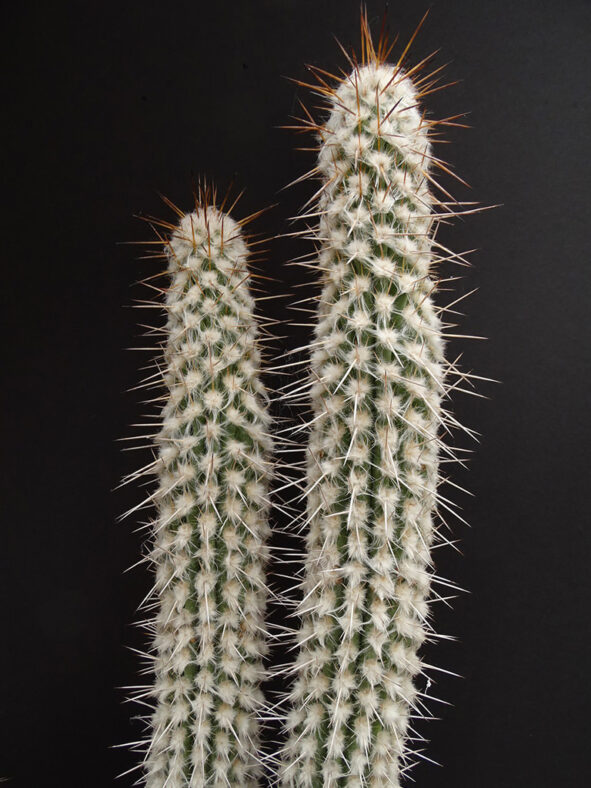Eulychnia saint-pieana is not recognized as a separate species and is treated as a synonym of Eulychnia breviflora.
Scientific Name
Eulychnia saint-pieana F.Ritter
Scientific Classification
Family: Cactaceae
Subfamily: Cactoideae
Tribe: Notocacteae
Genus: Eulychnia
Etymology
The specific epithet "saint-pieana" (pronounced "saint py-AH-nuh") probably honors Saint Pius V (Saint Pie V in Franch), who was Pope from 1566-1572 and one of the leading figures of the Catholic Reformation.
Origin
Eulychnia saint-pieana is native to northern Chile. It occurs in the coastal fog zone of the Atacama Desert.
Description
Eulychnia saint-pieana is a tree-like cactus with greyish-green or dark-green stems that feature 10 to 18 slightly tuberculate ribs lined with white, fluffy, closely set areoles. It typically has a well-defined but very short trunk and can grow up to 23 feet (7 m) tall. The upright stems can reach a diameter of 4.4 inches (11 cm). Each areole usually has 1 to 2 stout central spines measuring up to 8 inches (20 cm) long and 10 to 30 radial spines measuring up to 0.8 inches (2 cm) long. Initially, the spines are brownish to black but turn grey as they age.
During the summer, Eulychnia saint-pieana produces bell-shaped flowers that range from white to light pink. The pericarpel is covered with small, green scales and dense brownish wool but lacks stiff bristles. The flowers can reach a length of 2.8 inches (7 cm), including the pericarpel. The fruits are fleshy, spherical, and hairy, growing to a diameter of 2.4 inches (6 cm).

How to Grow and Care for Eulychnia saint-pieana
Light: Eulychnia saint-pieana thrives in full sun but can tolerate partial shade. On particularly hot summer days, light shade can be beneficial. If grown indoors, a sunny window is an ideal location. To promote balanced growth, rotate the pot a quarter turn every week or two. If possible, move the plant outdoors during the spring to fall.
Soil: This cactus prefers well-draining soil. You can either use a commercial cacus mix or make your own.
Hardiness: Eulychnia saint-pieana enjoys warm temperatures during the growing season but prefers cooler conditions in winter. It grows best in USDA Plant Hardiness Zones 10a to 11b, with average minimum winter temperatures ranging from 30 to 50 °F (-1.1 to 10 °C).
Watering: To keep your cactus healthy, water it thoroughly but allow the soil to dry out completely before the next watering. As fall approaches, gradually reduce the frequency of watering. During the winter dormancy, water the cactus just enough to prevent it from shrinking.
Fertilizing: Regular fertilizing during the growing season is beneficial. Use a balanced, water-soluble fertilizer diluted to 1/4 strength with each watering. A 10-10-10 fertilizer is ideal. However, stop fertilizing during the dormancy period.
Repotting: Repot Eulychnia saint-pieana once a year while it is young and as it outgrows its pot as it matures.
Propagation: The easiest method to propagate this cactus is by stem cuttings, as seed propagation is a slow process. Spring and summer are the best times to take cuttings and sow the seeds.
Learn more at How to Grow and Care for Eulychnia.
Toxicity of Eulychnia saint-pieana
Eulychnia saint-pieana is considered non-toxic.
Links
- Back to genus Eulychnia
- Succupedia: Browse succulents by Scientific Name, Common Name, Genus, Family, USDA Hardiness Zone, Origin, or cacti by Genus
Photo Gallery
Click on a photo to see a larger version.


